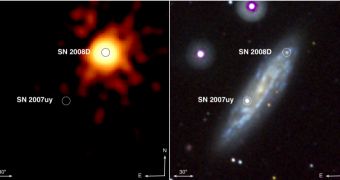On January 9, researchers from Princeton University pointed NASA's Swift satellite in the direction of the NGC 2770 galaxy, hopping to the see afterglow of a supernova explosion known as SN 2007uy, which had occurred only one month before. Instead, the team got a struck of luck and captured a five minute X-ray burst, emitted by a new supernova explosion taking place just before their eyes.
"For years we have dreamed of seeing a star just as it was exploding, but actually finding one is a once-in-a-lifetime event", said astronomer Alicia Soderberg, a Hubble and Carnegie Princeton Fellow at Princeton University. Soderberg believes that the discovery made by her team will unravel some of the secrets related to the early stages of these powerful explosions, as well as to their progenitor stars.
Supernova explosions occur when the progenitor star has depleted all its nuclear fuel and can no longer balance the gravitational and nuclear forces acting on it. The core of the star suffers a so-called gravitational collapse, turning into a neutron star - all baryonic matter is converted into neutrons - while the surplus material is ejected outwards and interacts with the outer layers of the star to produce a powerful explosion.
The phenomenon manifests itself through emissions of high amounts of X-ray radiation for a couple of minutes before fading away. This is the first time Soderberg and postdoctoral researcher at Princeton Edo Berger observe the full length of an X-ray signal coming from a supernova. Other such observations only captured the event as the electromagnetic emissions enhanced their intensity after the explosion had taken place.
"Using the most powerful radio, optical and X-ray telescopes on the ground and in space, we were eventually able to observe the evolution of the explosion right from the start. This eventually confirmed that the big X-ray blast marked the birth of a supernova", Berger said.
"We were in the right place, at the right time, with the right telescope on January 9th and witnessed history", Soderberg said.
Currently the evolution of the new supernova is monitored by an international collaboration using a range of telescopes, including the Hubble Space Telescope, The Gemini South Telescope, the Lick Observatory and the Keck I telescope.
According to investigations following the event, the supernova was of Type Ibc, meaning that it was determined by the explosion of a compact star.
"This first instance of catching the X-ray signature of stellar death is going to help us fill in a lot of gaps about the properties of massive stars, the birth of neutron stars and black holes, and the impact of supernovae on their environments", said Neil Gehrels, principal investigator of the Swift satellite.
The study of this particular X-ray burst, captured from beginning to end, could offer astronomers an opportunity to learn more about new supernova explosions and calculate their birth within a few seconds, rather than a few days. "We also now know what X-ray pattern to look for. Hopefully we will be able to find many more supernovae at this critical moment", Gehrels said.
The galaxy NGC 2770 lies about 90 million light years away from Earth in the Lynx constellation.

 14 DAY TRIAL //
14 DAY TRIAL //